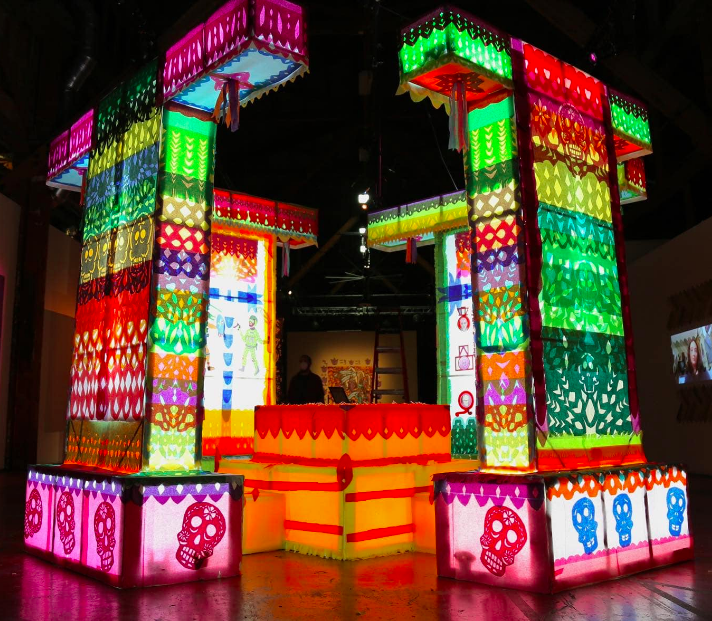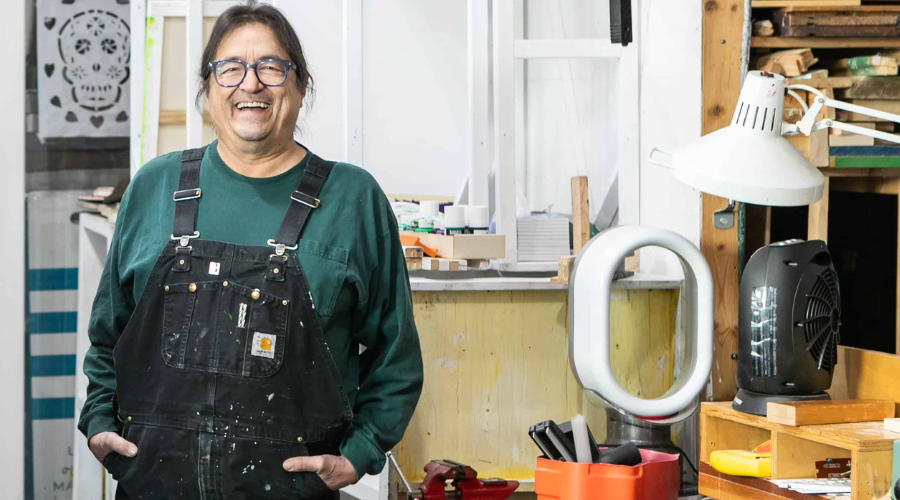| ARTS AND CULTURE
Six Questions by Jean Vengua
Víctor-Mario Zaballa grew up in a community surrounded by the works of the Mexican master muralists of the 20th century. All that art obviously had an impact.
Born in Mexico City in 1954, Zaballa said he has drawn from the history, symbolism and heritage of the world around him to inspire his own art. Despite a series of recent health issues, Zaballa said he continues to follow his inspiration.
Zaballa is currently an artist-in-residence at the Monterey Museum of Art. On display is the colorful, glowing “NECAUHCAYOTL, Gratitude Memento, Recuerdo de Gratitud,” a large-scale lantern installation and community altar that is the centerpiece of a Día de los Muertos celebration the museum is sponsoring on Saturday, Oct. 29.
Zaballa now lives in San Francisco, where his projects include work at the San Francisco BART station at 16th and Mission Street and the SOMArts Cultural Center. As a musician he has performed at Davies Symphony Hall and the Exploratorium, as well as the Lincoln Center in New York City.
Zaballa will lead an art workshop for all ages at a Día de los Muertos Family Fun Day at the Monterey Museum of Art from 11 a.m. to 1 p.m. Saturday. Zaballa’s art can be viewed at the museum through Nov. 6.
Enlarge

Filipinx American visual artist and writer Jean Vengua of Monterey, who also produces an online weekly arts-and-culture magazine called Eulipion Outpost, asked Zaballa six questions about his art, his influences and the creative process.
JV: Where did you grow up and how did that influence your art?
VMZ: I was born in 1954 into a working-class family in México. At that time, the 1910 Mexican Revolution’s goals of access to education, arts, science and culture were still relevant, and people took advantage of those hard-fought rights. Public schools, libraries, hospitals and markets were covered with murals and sculptures from Diego Rivera, José Clemente Orozco, David A. Siqueiros, Chávez Morado and others. Museums and classical and folk music concerts were inexpensive, if not free.
I was used to seeing Mayan and Toltec art and classical European art exhibitions. Discovering contemporary modern, experimental music and art was a life-changing experience for me.
When I was 6 years old, I saw an exhibition of contemporary art. The first gallery had modern watercolor paintings. I asked why all these pictures were there, and was told that they were the work of that artist. The second gallery had photographs, and I asked again why those photos were in the gallery. Again, the answer was that it was the work of that artist. By the time we entered the third gallery with wood sculptures, I felt I could identify with the people who had created it. And then, a realization came to me; I asked my grandmother if being an artist was a job just like being a fireman, an astronaut or an engineer. The answer was “yes.” I said, “I can do that too,” and decided to be an artist then and there. I never looked back.
JV: What’s your creative process like?
VMZ: My work synthesizes my interests in science, history and traditional elements. I combine flowers, food, feathers, paper, ceramics, stone, glass, metal and wood carvings with contemporary mediums, such as photography, film, video and electronic musical instruments. In my performances and exhibits, I blend traditional Mexican altar installations, mural painting, and Pre-Columbian musical instruments with electronic music and projected images.
For me, the challenge of developing art practice is the awareness that there is no static spectator in public art.
JV: What puts a damper on your creativity? What do you do — if anything — to remedy that?
VMZ: In 2003, I had a stroke … followed by problems with my kidney that required years of dialysis. But none of it stopped me. I focused on large art projects to help get me through. I believe that something bad must be used to your advantage. And the result was the best public art I’ve ever done.
JV: Does age (or any other physical issue) factor into your creative process, and if yes, how?
VMZ: This year, I had cancer in my eye. After treatment and surgeries, I am okay, but I have lost most of my sight in the right eye. I can still do my art. I cut my papel picado designs from touch and memory. My hands know what to do.
JV: What are you working on currently, and what impels or inspires it?
VMZ: My artist residency at Monterey Museum of Art, “NECAUHCAYOTL, Gratitude Memento, Recuerdo de Gratitud,” continues through November 6.
The origins of the day of the dead are a thanksgiving celebration for the fruits of the harvest. Through the altars, we express our gratitude to our beloved departed ones who have protected our crops from the elements. Crafting paper flowers, cutting papel picado, baking special bread, and making toys for the altars are mementos that give us a chance to thank our beloved ones for the time they shared with us during their lives.
At the same time, we acknowledge our gratitude for being here and now.
This time is our time.
JV: What’s your favorite imperfection?
VMZ: Imperfections or mistakes in my art are opportunities to try something new. The question of whether to correct it or use it is obvious to me. With papel picado, I can explore new shapes from a different cut. For much of my life, I had very little resources for my art. The choice could be paint or food. In this reality, you learn to use mistakes and embrace imperfections.
Enlarge

Have something to say about this story? Send us a letter.